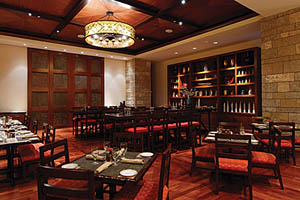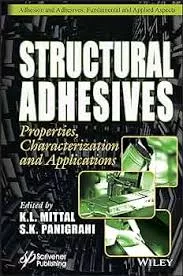Cover Story
Discovering High-Performance, Low-VOC Adhesives
 Woodhaus, Inc. has been in business for 10 years as a commercial millwork subcontractor, serving Dallas-Fort Worth, greater Texas, and areas beyond in the South-Central and Southwest regions of the U.S. We offer additional value to customers with service differentiators such as employing crews for on-site installation, providing value engineering, reviewing clients’ project requirements and making recommendations about how to stay on budget. Material sourcing is also an important part of what we do, and we apply our material knowledge to make recommendations that will help clients achieve their goals at the best possible price.
Woodhaus, Inc. has been in business for 10 years as a commercial millwork subcontractor, serving Dallas-Fort Worth, greater Texas, and areas beyond in the South-Central and Southwest regions of the U.S. We offer additional value to customers with service differentiators such as employing crews for on-site installation, providing value engineering, reviewing clients’ project requirements and making recommendations about how to stay on budget. Material sourcing is also an important part of what we do, and we apply our material knowledge to make recommendations that will help clients achieve their goals at the best possible price.
In millwork and cabinetry, wood veneering and lamination are everyday projects, and Woodhaus has seen a number of products come in and out of favor for this task. As part of our work in value engineering and responsible material sourcing, we have consulted with clients over the past few years about converting to more eco-friendly adhesives for lamination. For years, the odor and vapor of roll-on glues have irritated workers in the field, and many people have suspected that exposure to these chemicals may be detrimental to workers’ health.
However, until very recently, the “greener” adhesive alternatives that were offered did not provide the necessary level of performance, either in their features or in their long-term durability. In fact, we were called back by a customer on one large project to re-laminate areas where glue was coming loose after only a few months. Recalls like this can be costly and can strain relationships with customers. Such experiences suggested that the benefits of low volatile organic compound (VOC) adhesives were very limited if they could not offer the same functionality and durability as the products we used most often.
THE LATEST GENERATION
Fortunately, the current generation of low-VOC adhesives has shown us that using the newest eco-friendly adhesives does not have to mean compromising product performance. We have recently been using 3M™ Hi-Strength 94 ET Spray Adhesive, which we have found to be ideal for our needs. The adhesive bonds not only laminates, woods, metals and particleboard, but also soft foams, lighter weight materials, and substrates with more porous surfaces.
The spray pattern for this adhesive is designed to prevent telegraphing through thin veneers and glossy laminates, giving us the confidence to apply it even with challenging materials. In addition, it has a very high solids content, which correlates to more coverage per pound of adhesive. This improved yield means we get a better value out of every pound.
When working with a large room of laminate counters and cabinetry, we require an adhesive with a long hold-open time. In the past, we were accustomed to products that gave our team an approximately 15-minute window, but 3M Hi-Strength 94 ET Spray Adhesive allows for an hour of open time. This flexibility is very important on a project and gives our team the best possible opportunity for a perfect installation.
In addition to being low VOC, this adhesive contributes to LEED® credits and has received certification for GREENGUARD™ Children & Schools. This certification recognizes low-emitting building materials and other products used in environments where children and other sensitive populations spend extended periods of time. It also meets standards for the California Air Resource Board (CARB)/Ozone Transport Commission (OTC) VOC requirements, which regulate VOC levels of many consumer products with the goal of improving air quality, as well as the South Coast Air Quality Management District (SCAQMD) Rule 1168, an air quality regulation on VOC emissions in southern California. All of these certifications give us added assurance when working on projects such as hospitals or hotels, where air quality is especially important.
ADDED VALUE
Professionals in the industry understand the purpose of the LEED movement, but using products and materials to contribute to LEED credits can sometimes be inconvenient. However, “green” buildings have a growing market value that is reflected in their sale and lease pricing, and clients are increasingly demanding their building suppliers cooperate in their efforts to achieve LEED certification. In light of this trend, contractors and subcontractors are coming to terms with using a new class of materials.
We believe that the adhesive industry has reached a point where green products do not compromise performance in any way. In addition, prices for these products have come down to the point where they are equivalent to the prices for the past generation of products. As seen by the example discussed here, the better yield means that a low-VOC adhesive may even cost less than its predecessor.
After approximately one year of experience with 3M Hi-Strength 94 ET Spray Adhesive, we have seen ample evidence of its dependability. With no callbacks and no evidence of failure, we are convinced that its dependability has caught up to the past generation and we have no qualms about using it. Knowing that the industry is heading farther down the road of environmentally friendly materials with each passing day, we are proud to have the experience in material sourcing to know that our adhesive product meets clients’ new criteria. We feel that this experience and knowledge help us maintain our added value in effective installation, value engineering, and material sourcing.
For additional information, contact the author at (972) 245-8117 or georgec@woodhausinc.com. 3M’s website is located at www.3m.com.
Looking for a reprint of this article?
From high-res PDFs to custom plaques, order your copy today!




